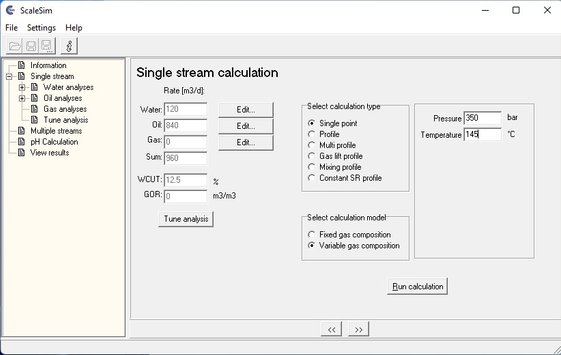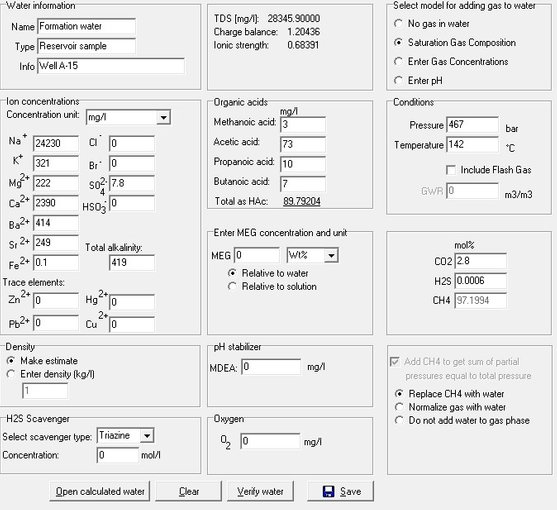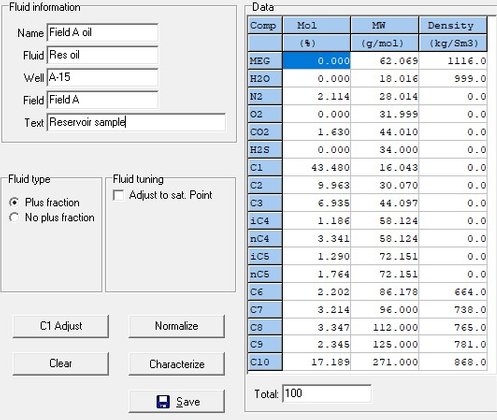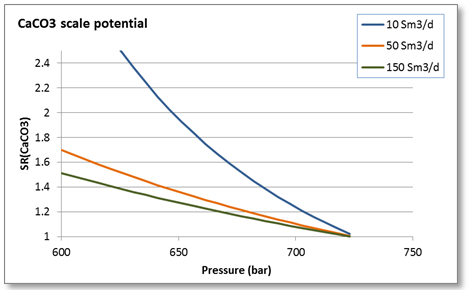The Basic module
ScaleSim - The basic module
The basic module is the main software used for entering water, oil and gas analyses and for running normal scale simulations. The basic module is designed for scale simulations in oil and gas wells, but can of course be used for any system.
The simulation concept is to first compose a stream that contains everything in a wellstream.This is done by adding water, oil and/or gas to the simulator, perform necessary tuning of water, alkalinty etc. and set flow rates of the different phases. ScaleSim will then combine all the phases into one well stream. In the example to the right, the water rate is 120 m3/d and the oil rate is 840 m3/d.
ScaleSim includes all the normal scale types:
- Carbonates (CaCO3, FeCO3)
- Sulphates (BaSO4, SrSO4, CaSO4)
- Sulphides (FeS, ZnS, PbS)
- Chlorides (NaCl, KCl)
and many other less common salts and minerals. ScaleSim is tested against experimental data in the range 0-2000 bar and 0-200°C, but model can safely be used up to 3000 bar and 300°C.
ScaleSim - Water analysis input
A simulation can never be better than the input data. To generate a well stream, user must specify water composition and oil gas composition.
All the ions normally found in formation waters can be specified. In addition, all the 4 shortes organic acids can be added. The water can furhter be saturated with CO2/H2S at given conditions, for example in the reservoir or at a topside sampling point. There are also alternative options for specifying amount of dissolved gas in the water.
In the water analysis, the user may also create waters/fluids that contain H2S scavenger, MEG, MDEA and dissolved oxygen.
Oil/gas compositions are specified with all the normal hydrocarbon components from CO2, N2, H2S, CH4, C2, etc up to C10+.
Up to 6 differnet waters can be included in a simulation, each with individual flow rates. A typical example would be to enter both formation water and seawater with individual rates. ScaleSim will then mix the waters and calculate scale potentials in the mixture.
ScaleSim - Oil and gas analysis input
ScaleSim is unique because it contains a full Equation of State (EOS) based PVT model, similar to the PVT models used by PVT programs and process simulation programs.
The user specifies all the components from N2, O2, CO2, H2S, CH4 etc. up to C10+. C6-C9 are pseudo components and their properties are found from the specified molecular weights and densities. The C10+ is split up into 9 pseudo components with carbon numbers ranging from 10-80 based on well established characterisation procedures.
Both the Soave Redlich Kwong (SRK) and the Peng and Robinson (PR) EOS can be selected and the model uses the Peneloux volume correction to get better liquid densities and the Huron Vidal mixing rule for water.
ScaleSim can therefore also be used as a pure PVT simulator and will caluclate phase compositions and phase properties in the same way as other PVT/Process simulators.
The PVT-mode is fully integrated with the water phase model such that when a simulation is run, there is full equilibrium between the water phase and oil/gas phase(s) present.
Oil/gas can be entered as reservoir composition or flashed compositions. If the reservoir composition is known, this can be entered directly. If it is an oil well, it is entered as an oil and the oil rate is given. If it is a gas well, it is entered as a gas and gas rate is given. When entering the flow rates, user can choose to enter the flow rate in standard volume at standard conditions or as actual volume at actual conditions.
It is also possible to enter BOTH oil and gas, for example based on PVT samples taken from test separator. Both oil and gas rates must be given, and the oil and the gas will then be recombined by ScaleSim in the simulation.
Alternatively, if the well has a gas cap, the reservoir fluid and the gas cap can be entered and the flow rate of the gas cap can be adjusted to match the topside GOR.
ScaleSim - Simulations
The Following simulation typse are available:
- Single Point - A single calculation at a given P and T
- Profiles – Automatically run pressure and/or temperature profiles from start conditions to end conditions. Both P and T can be varied simulataneously. A typical example is to evaluate risk for CaCO3 scale when pressure is reduced.
- Mixing profile - Mix two waters, for example formation water and seawater from 0 to 100%. This is the classic simulation to evaluate risk of sulphate scale with seawater breakthrough.
- MultiProfile – With the MultiProfile, P and/or T can be varied independently in several sub-profiles to simulate how scale potential varies along a full well path. The differnet sub-profiles could represent Reservoir -> Well, Well -> wellhead, Upstream -> downstream choke etc.
- Gas lift simulation – This is a profile simulations where a gas stream is added to simulate effect of lift gas injection.
- Constant SR profile – Perform a detailed well analysis by simulating a scale risk diagram and plot in how the scale risk in the well varies with pressure and temperature.
ScaleSim - Tuning
ScaleSim has automatic tuning functionality ot water-saturate the oil gas and to tune alkalinity to calcite saturation.
After entering the compositions and flow rates, the tuning option is used to:
- Saturate the hydrocarbon phase (oil+gas) with water according to the vapor pressure of the water at the given P and T (for example reservoir). Vapor pressure is of course corrected for the salinity of the water
- Automatic tuning of alkalinity and CO2 content in water phase such that the water is calcite saturated at reservoir conditions.
ScaleSim - Speed and Simplicity
ScaleSim is extremely fast, and a simulation normally takes a few hundreds of a second. Even if you run a full profile simulation with 25 different pressures and temperatures, the simulation is done in less than a second. The results from the simulation are displayed immediately in the program in form of tables in a text file. The results can also be taken directly to a plot program or to Excel, where you can set up tables and graphs that can be copied directly to your report.





